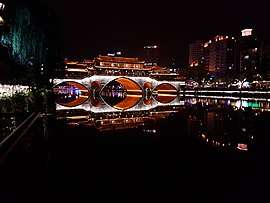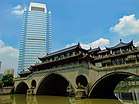Anshun Bridge
The Anshun Bridge (Chinese: 安顺桥; lit.: 'Peaceful and Fluent') is a bridge in the provincial capital of Chengdu in Sichuan, China. It crosses the Jin River. The covered bridge contains a relatively large restaurant and is a popular eating location in the city.
Anshun Bridge | |
|---|---|
 View of the Anshun Bridge along the Jin River at night in Chengdu, China | |
| Coordinates | 30°38′39″N 104°05′00″E |
| Carries | Pedestrians only |
| Crosses | Jin River |
| Locale | Chengdu, Sichuan Province, China |
| Official name | 安顺廊桥 |
| Characteristics | |
| Design | Arch bridge |
 Anshun Bridge Location in Sichuan | |
History
The original Anshun Bridge was constructed in 1746 by Lingan Hongdui along the Jin River. In 1947, a flood ravaged the city and destroyed the original bridge.[1]
The bridge was constructed in 2003 as a replacement of the old bridge which was destroyed by a flood in the 1980s.[2]
In the 13th century, Marco Polo wrote about several bridges in China and the Anshun Bridge (an earlier version of it) was one of them.[3][4]
Gallery
 Anshun Bridge at night
Anshun Bridge at night The Anshun Bridge crosses the Jin River in Chengdu
The Anshun Bridge crosses the Jin River in Chengdu Bridge detail
Bridge detail The bridge in 2012
The bridge in 2012
gollark: Just write while mostly ignoring the movie.
gollark: You need to buy wire to make more.
gollark: Relatedly, here's a fun incremental game! https://www.decisionproblem.com/paperclips/index2.html
gollark: CLIP is quite exciting. All should know about it.
gollark: Good, good.
References
- "安顺桥". Baidu Baike.
- Chengdu Time Archived 2007-05-16 at the Wayback Machine
- Quian, Jack, Chengdu: A City of Paradise, 2006. Cf. p.109
- Marco Polo referred to Chengdu as Sindafu (variously spelled in different editions as "Sin-din-fu". &c.) which was certainly Ch'eng-Tu-Fu (Chengdu), the capital of Sichuan province. Cf. Polo, Chapter XLIV: Concerning the Province and City of Sindafu. See Henry Yule; Henri Cordier (translators and editors), The Travels of Marco Polo, v.2, the complete Yule-Cordier edition. "Let us now speak of a great Bridge which crosses this River within the city. This bridge is of stone; it is seven paces in width and half a mile in length (the river being that much in width as I told you); and all along its length on either side there are columns of marble to bear the roof, for the bridge is roofed over from end to end with timber, and that all richly painted. And on this bridge there are houses in which a great deal of trade and industry is carried on. But these houses are all of wood merely, and they are put up in the morning and taken down in the evening. Also there stands upon the bridge the Great Kaan's _Comercque_, that is to say, his custom-house, where his toll and tax are levied."
This article is issued from Wikipedia. The text is licensed under Creative Commons - Attribution - Sharealike. Additional terms may apply for the media files.